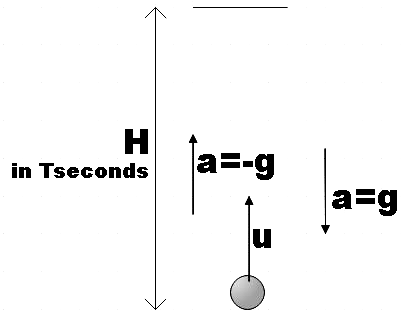Answer
396.9k+ views
Hint: Firstly, you could use the equations of motion for the body at maximum height H and time T. Then you could make use of the equation of motion for some height h at time t. After that, you could relate the two equations and then make necessary changes and thus find the required relation.
Formulae used:
Equations of motion,
$v=u+at$
$s=ut+\dfrac{1}{2}g{{t}^{2}}$
Complete Step by step solution:
In the question, we are given a particle that is being projected vertically upwards. We are given that the particle reaches a maximum height H in time T seconds and we are asked to find the height of the particle at any given time t.
We know that at maximum height the velocity of the particle will be zero, that is,
$v=0m{{s}^{-1}}$

Let the initial velocity of the particle be u when projected, then, by equation of motion we have,
$v=u+at$
$\Rightarrow 0=u-gT$
$\therefore u=gT$ ………………………………. (1)
Also, we have another equation of motion given by,
$H=uT-\dfrac{g{{T}^{2}}}{2}$
Substituting (1), we get,
$\Rightarrow H=g{{T}^{2}}-\dfrac{g{{T}^{2}}}{2}$
$\therefore H=\dfrac{g{{T}^{2}}}{2}$ ………………………………………….. (2)
Let the height of the particle be h for any time t, then, by equation of motion we have,
$s=ut+\dfrac{1}{2}g{{t}^{2}}$
$\Rightarrow h=ut-\dfrac{1}{2}g{{t}^{2}}$
Substituting (1),
$h=gTt-\dfrac{1}{2}g{{t}^{2}}$
Now let us add and subtract $\dfrac{1}{2}g{{T}^{2}}$ on the right hand side, then,
$h=gTt-\dfrac{1}{2}g{{t}^{2}}-\dfrac{1}{2}g{{T}^{2}}+\dfrac{1}{2}g{{T}^{2}}$
$\Rightarrow h=\left( gTt-\dfrac{1}{2}g{{t}^{2}}-\dfrac{1}{2}g{{T}^{2}} \right)+\dfrac{1}{2}g{{T}^{2}}$
But from (2),$H=\dfrac{g{{T}^{2}}}{2}$ so, h becomes,
$h=-\dfrac{1}{2}g\left( -\dfrac{1}{2}Tt+{{t}^{2}}+{{T}^{2}} \right)+H$
$\therefore h=H-\dfrac{1}{2}g{{\left( t-T \right)}^{2}}$
Therefore, we found that the height of the particle at any time t will be,
$h=H-\dfrac{1}{2}g{{\left( t-T \right)}^{2}}$
Hence, option B is found to be the correct answer.
Note:
We know that, by convention we take acceleration due to gravity positive when the motion of the body is downwards. Since, here the body’s motion is upwards, we have taken it to be negative. Also, when a particle is projected vertically upwards, we know that it goes to rest and maximum height and returns downwards and hence the velocity at maximum height is zero.
Formulae used:
Equations of motion,
$v=u+at$
$s=ut+\dfrac{1}{2}g{{t}^{2}}$
Complete Step by step solution:
In the question, we are given a particle that is being projected vertically upwards. We are given that the particle reaches a maximum height H in time T seconds and we are asked to find the height of the particle at any given time t.
We know that at maximum height the velocity of the particle will be zero, that is,
$v=0m{{s}^{-1}}$

Let the initial velocity of the particle be u when projected, then, by equation of motion we have,
$v=u+at$
$\Rightarrow 0=u-gT$
$\therefore u=gT$ ………………………………. (1)
Also, we have another equation of motion given by,
$H=uT-\dfrac{g{{T}^{2}}}{2}$
Substituting (1), we get,
$\Rightarrow H=g{{T}^{2}}-\dfrac{g{{T}^{2}}}{2}$
$\therefore H=\dfrac{g{{T}^{2}}}{2}$ ………………………………………….. (2)
Let the height of the particle be h for any time t, then, by equation of motion we have,
$s=ut+\dfrac{1}{2}g{{t}^{2}}$
$\Rightarrow h=ut-\dfrac{1}{2}g{{t}^{2}}$
Substituting (1),
$h=gTt-\dfrac{1}{2}g{{t}^{2}}$
Now let us add and subtract $\dfrac{1}{2}g{{T}^{2}}$ on the right hand side, then,
$h=gTt-\dfrac{1}{2}g{{t}^{2}}-\dfrac{1}{2}g{{T}^{2}}+\dfrac{1}{2}g{{T}^{2}}$
$\Rightarrow h=\left( gTt-\dfrac{1}{2}g{{t}^{2}}-\dfrac{1}{2}g{{T}^{2}} \right)+\dfrac{1}{2}g{{T}^{2}}$
But from (2),$H=\dfrac{g{{T}^{2}}}{2}$ so, h becomes,
$h=-\dfrac{1}{2}g\left( -\dfrac{1}{2}Tt+{{t}^{2}}+{{T}^{2}} \right)+H$
$\therefore h=H-\dfrac{1}{2}g{{\left( t-T \right)}^{2}}$
Therefore, we found that the height of the particle at any time t will be,
$h=H-\dfrac{1}{2}g{{\left( t-T \right)}^{2}}$
Hence, option B is found to be the correct answer.
Note:
We know that, by convention we take acceleration due to gravity positive when the motion of the body is downwards. Since, here the body’s motion is upwards, we have taken it to be negative. Also, when a particle is projected vertically upwards, we know that it goes to rest and maximum height and returns downwards and hence the velocity at maximum height is zero.
Recently Updated Pages
How many sigma and pi bonds are present in HCequiv class 11 chemistry CBSE

Why Are Noble Gases NonReactive class 11 chemistry CBSE

Let X and Y be the sets of all positive divisors of class 11 maths CBSE

Let x and y be 2 real numbers which satisfy the equations class 11 maths CBSE

Let x 4log 2sqrt 9k 1 + 7 and y dfrac132log 2sqrt5 class 11 maths CBSE

Let x22ax+b20 and x22bx+a20 be two equations Then the class 11 maths CBSE

Trending doubts
Fill the blanks with the suitable prepositions 1 The class 9 english CBSE

At which age domestication of animals started A Neolithic class 11 social science CBSE

Which are the Top 10 Largest Countries of the World?

Give 10 examples for herbs , shrubs , climbers , creepers

Difference between Prokaryotic cell and Eukaryotic class 11 biology CBSE

Difference Between Plant Cell and Animal Cell

Write a letter to the principal requesting him to grant class 10 english CBSE

Change the following sentences into negative and interrogative class 10 english CBSE

Fill in the blanks A 1 lakh ten thousand B 1 million class 9 maths CBSE



